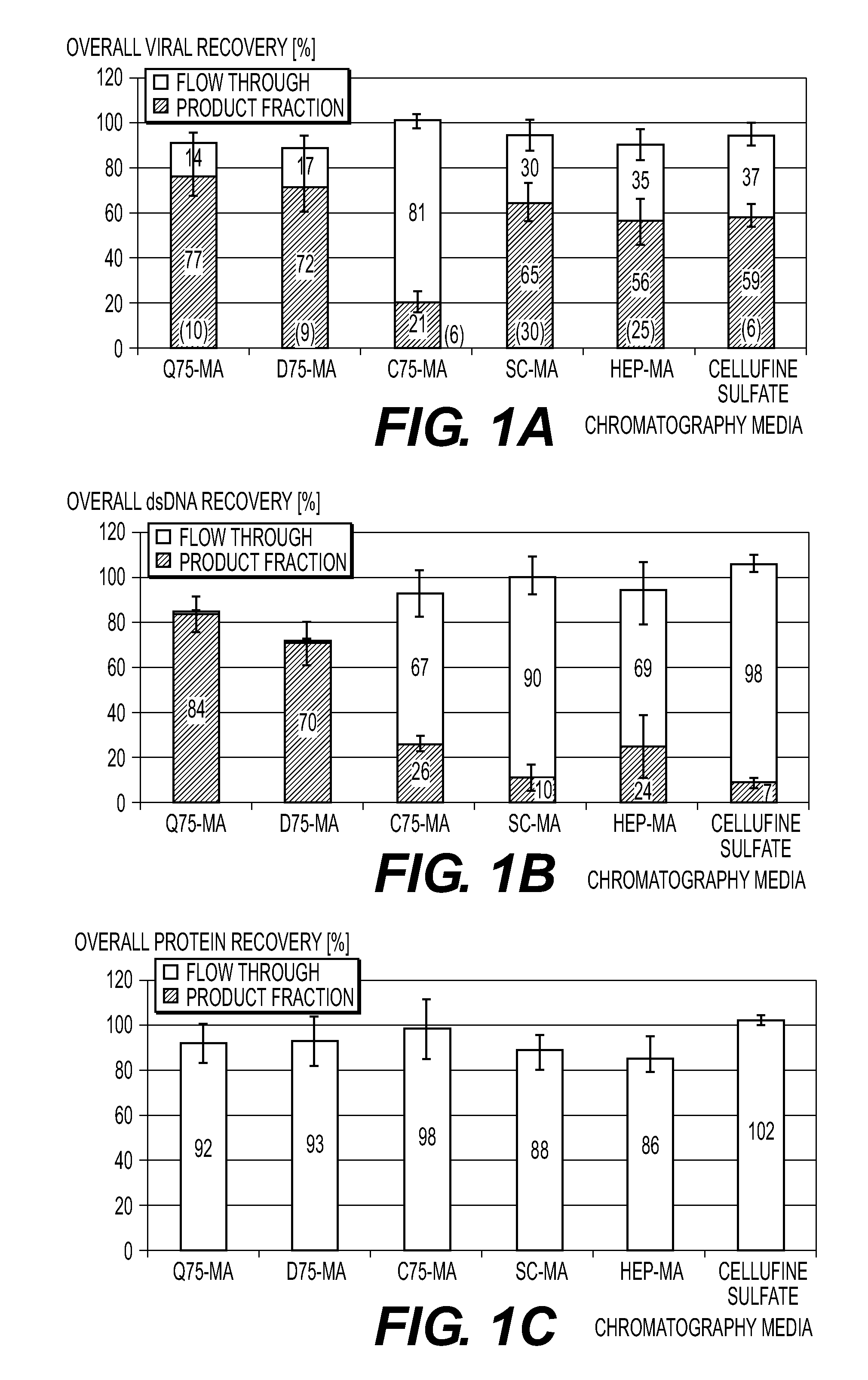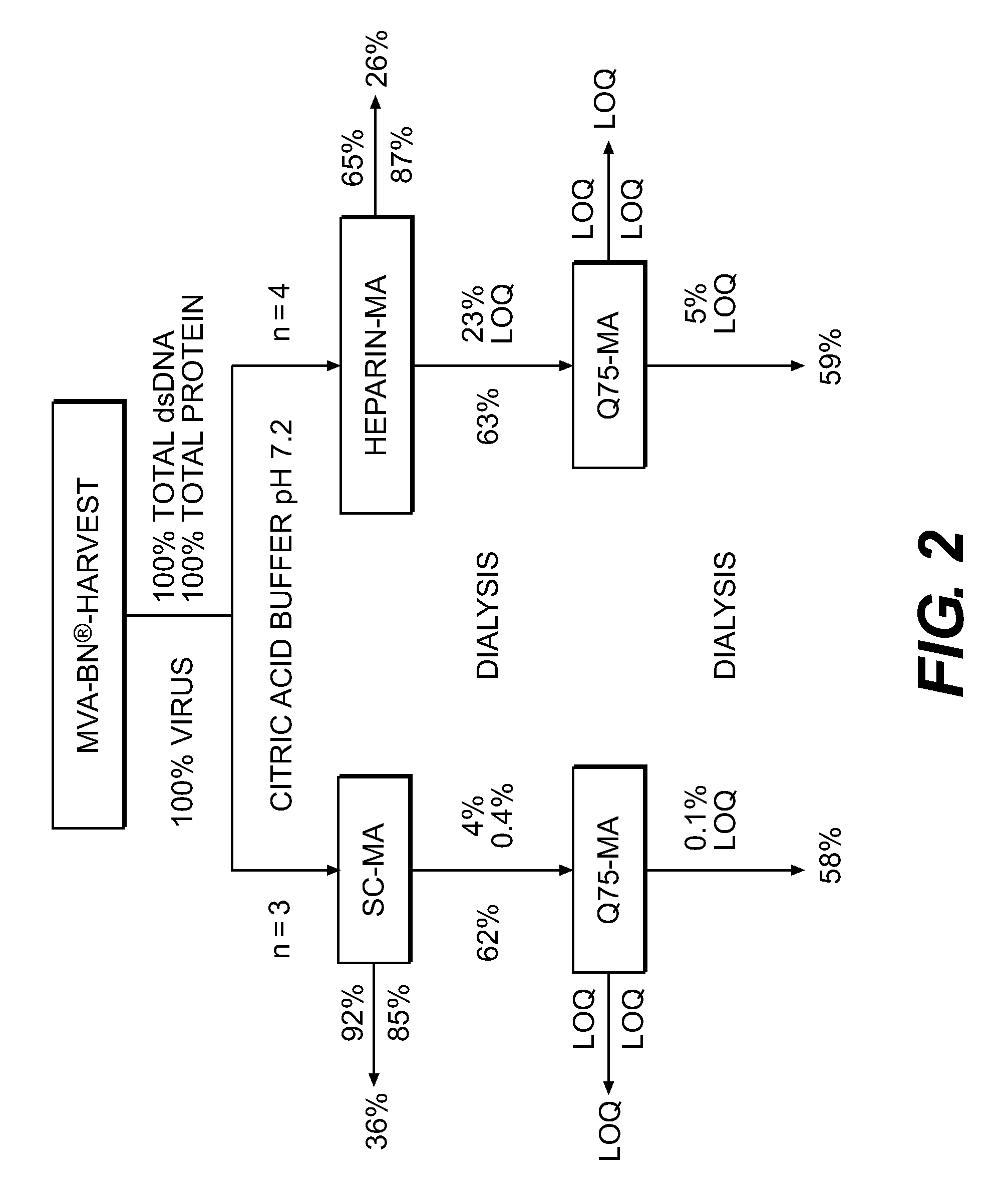Purification of vaccinia virus- and recombinant vaccinia virus-based vaccines
a technology of vaccinia virus and purification method, which is applied in the field of purification method of vaccinia virus and/or vaccinia virus (vv) particles, can solve the problems of high neurovirulence, poor suitability for human and animal use, and potential mutation of poxviruses such as cowpox, camelpox and monkeypox
- Summary
- Abstract
- Description
- Claims
- Application Information
AI Technical Summary
Benefits of technology
Problems solved by technology
Method used
Image
Examples
example 1
[0175]Two ml of a highly concentrated and previously purified Vaccinia virus preparation with approximately 2×109 virus particles per ml were applied to a column with packed with Toyopearl AF-Heparin.
[0176]The column was washed with PBS 0.01 M, 0.15 M NaCl, pH 7.2. The A280 absorbance signal used for monitoring of Vaccinia virus particle and host cell protein concentrations returned to baseline (the pre-loading value) after 12 minutes. The washing continued for a total of 25 minutes.
[0177]The bound Vaccinia virus particles were eluted by a NaCl concentration gradient in PBS 0.01 M, pH 7.2. The concentration of NaCl was increased linearly from 0.15 M to 2.0 M. The elution started after approximately a total of 30 minutes (5 minutes after starting the gradient). The major peak was eluted 7 minutes later (at T=37 minutes). The peak contained a high concentration of Vaccinia virus particles as assessed by the Laser Scattering signal used for monitoring of Vaccinia virus particles. The e...
example 2
[0179]Two ml of a highly concentrated and previously purified Vaccinia virus preparation with approximately 2×109 virus particles per ml was applied to a Sartobind MA75 Heparin membrane.
[0180]The membrane was washed with PBS 0.01 M, 0.15 M NaCl, pH 7.5. The A280 absorbance signal used for monitoring of Vaccinia virus particle and host cell protein concentrations returned to baseline (the pre-loading value) after 12 minutes. The washing continued for a total of 16 minutes.
[0181]The bound Vaccinia virus particles were eluted by a NaCl concentration gradient in PBS 0.01 M, pH 7.5. The concentration of NaCl was increased linearly from 0.15 M to 2.0 M. The elution started after approximately a total of 20 minutes (4 minutes after starting the gradient). The major peak was eluted 5 minutes later (at T=25 minutes). The peak contained a high concentration of Vaccinia virus particles as assessed by the Laser Scattering signal used for monitoring of Vaccinia virus particles.
[0182]The eluate w...
example 3
[0183]Two ml of a highly concentrated Vaccinia virus preparation with approximately 2×109 virus particles per ml are applied to a Sartobind MA75 Heparin membrane.
[0184]The membrane is washed with PBS 0.01 M, 0.15 M NaCl, pH 7.5. The A280 absorbance signal is used for monitoring of Vaccinia virus particle and the host cell protein concentrations until it returns to baseline (the pre-loading value). The washings are continued for a total of 20 minutes.
[0185]The bound Vaccinia virus particles are eluted by a pH concentration gradient in GBS 0.02 M, 0.15 M NaCl. The initial pH is 8.5, increasing to pH 10.5. The concentration of NaCl is increased linearly from 0.15 M to 2.0 M.
[0186]The eluate is analyzed by titration for viable (infectious) Vaccinia virus particles by a Tissue Culture cytopathic effect assay (TCID50), for total number of Vaccinia virus particles by a real-time qPCR for Vaccinia DNA, for host cell protein by use of the BCA total protein assay and for host cell DNA by use ...
PUM
| Property | Measurement | Unit |
|---|---|---|
| pore size | aaaaa | aaaaa |
| diameter | aaaaa | aaaaa |
| volume | aaaaa | aaaaa |
Abstract
Description
Claims
Application Information
 Login to View More
Login to View More - R&D
- Intellectual Property
- Life Sciences
- Materials
- Tech Scout
- Unparalleled Data Quality
- Higher Quality Content
- 60% Fewer Hallucinations
Browse by: Latest US Patents, China's latest patents, Technical Efficacy Thesaurus, Application Domain, Technology Topic, Popular Technical Reports.
© 2025 PatSnap. All rights reserved.Legal|Privacy policy|Modern Slavery Act Transparency Statement|Sitemap|About US| Contact US: help@patsnap.com



